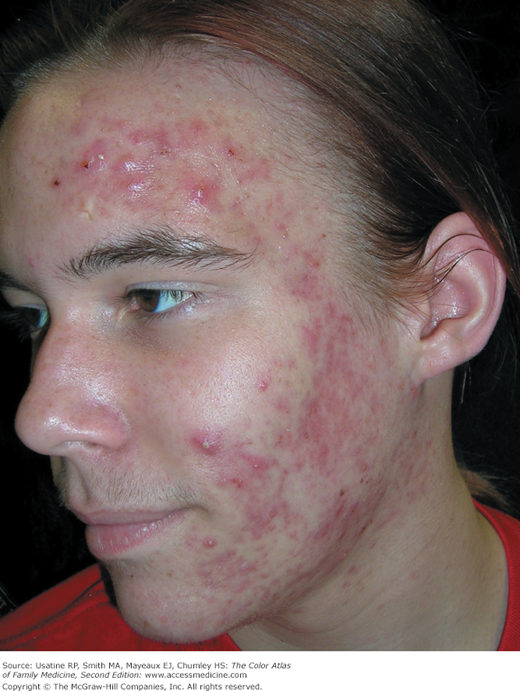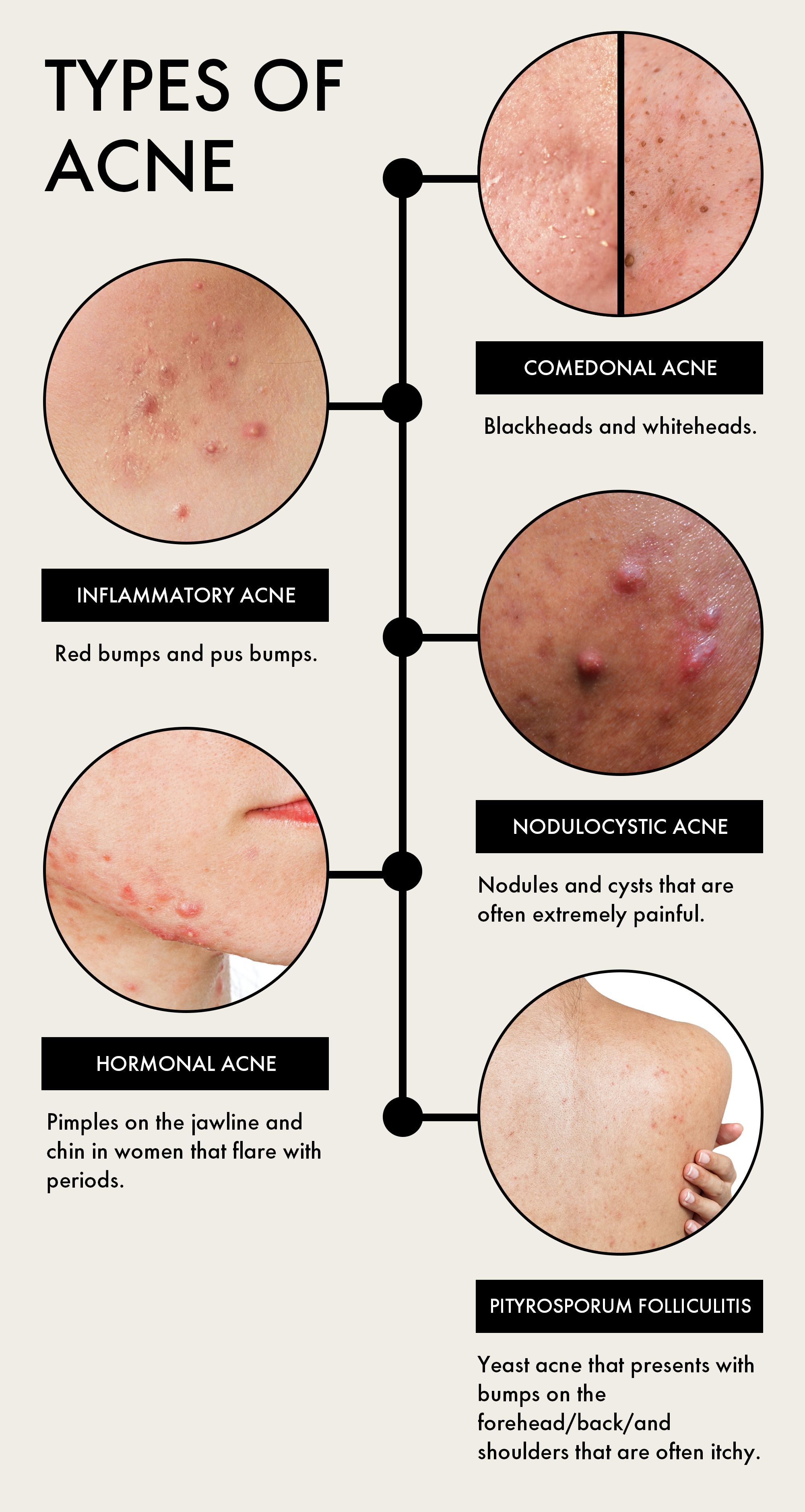Acne vulgaris is a common cutaneous inflammatory disorder of the pilosebaceous unit, which runs a chronic course. The condition commonly manifests with papules, pustules, or nodules primarily on the face, although it can also affect the upper arms, trunk, and back. The pathogenesis of acne vulgaris involves the interaction of multiple factors that ultimately lead to the formation of its
Learn about acne vulgaris, the most common skin condition that causes pimples. Find out how to diagnose, treat and prevent acne with tips from Cleveland Clinic experts.
Acne vulgaris merupakan istilah medis yang merujuk pada berbagai jenis jerawat. Kondisi yang biasanya muncul di wajah dan punggung ini dapat disebabkan oleh berbagal hal dan ditangani dengan berbagai cara.
Acne vulgaris is a common skin condition caused by blocked pores and inflammation. Learn about the types, symptoms, causes, diagnosis, and treatment of acne vulgaris, and how to prevent scarring and complications.
Acne vulgaris is a common skin condition occurring when hair follicles become clogged with oil and dead skin cells, leading to bacterial overgrowth and inflammation.
Learn about acne vulgaris, the most common skin condition that causes pimples. Find out how to diagnose, treat and prevent acne with tips from Cleveland Clinic experts. Acne vulgaris merupakan istilah medis yang merujuk pada berbagai jenis jerawat. Kondisi yang biasanya muncul di wajah dan punggung ini dapat disebabkan oleh berbagal hal dan ditangani dengan berbagai cara. Acne vulgaris is a common skin condition caused by blocked pores and inflammation.
Learn about the types, symptoms, causes, diagnosis, and treatment of acne vulgaris, and how to prevent scarring and complications. Acne vulgaris is a common skin condition occurring when hair follicles become clogged with oil and dead skin cells, leading to bacterial overgrowth and inflammation.
Acne vulgaris is the most prevalent chronic skin disease in the United States, affecting nearly 50 million people per year, mostly adolescents and young adults. Potential sequelae of acne, such as scarring, dyspigmentation, and low self-esteem, may result in significant morbidity. Typical acne lesio …
Acne vulgaris is the formation of comedones, papules, pustules, nodules, and/or cysts as a result of obstruction and inflammation of pilosebaceous units (hair follicles and their accompanying sebaceous gland). Acne develops on the face and upper trunk. It most often affects adolescents. Diagnosis is by examination.
Learn about the common form of acne, its causes, complications, and how to treat it. Find out how acne varies in skin of colour, how to grade it, and what to avoid.
Milde acne Matig-ernstige acne Ernstige acne; Initiële behandeling: benzoylperoxide of adapaleen of tretinoïne (wissel als tussenstap eventueel tussen benzoylperoxide en adapaleen/tretinoïne)
Acne - NHG-Richtlijnen
Acne vulgaris is the most prevalent chronic skin disease in the United States, affecting nearly 50 million people per year, mostly adolescents and young adults. Potential sequelae of acne, such as scarring, dyspigmentation, and low self-esteem, may result in significant morbidity. Typical acne lesio … Acne vulgaris is the formation of comedones, papules, pustules, nodules, and/or cysts as a result of obstruction and inflammation of pilosebaceous units (hair follicles and their accompanying sebaceous gland). Acne develops on the face and upper trunk. It most often affects adolescents.
Diagnosis is by examination. Learn about the common form of acne, its causes, complications, and how to treat it. Find out how acne varies in skin of colour, how to grade it, and what to avoid. Milde acne Matig-ernstige acne Ernstige acne; Initiële behandeling: benzoylperoxide of adapaleen of tretinoïne (wissel als tussenstap eventueel tussen benzoylperoxide en adapaleen/tretinoïne)
The medical term for acne is acne vulgaris. What are the types of acne? There are several types of acne, including: Cystic acne: Cystic acne causes deep, pus-filled pimples and nodules.These can cause scars. Fungal acne (pityrosporum folliculitis): Fungal acne occurs when yeast builds up in your hair follicles.These can be itchy and inflamed.
Acne vulgaris was the eighth most prevalent disease globally in 2010, whereas fungal skin diseases was fourth in global prevalence, and other skin and subcutaneous diseases was in fifth place 2
Acne is a skin condition caused by oil and dead skin cells clogging hair follicles. It can range from mild to severe and may cause scarring or emotional distress. Learn about the factors that trigger or worsen acne and how to treat it.
Acne vulgaris is one of the most common skin conditions diagnosed and treated by dermatologists in the United States (US) and worldwide. 1, 2 These guidelines aim to provide evidence-based recommendations to guide the clinical management of acne vulgaris for adults, adolescents, and preadolescents aged 9 years or older from the perspectives of US and Canadian dermatologists, clinicians who
Guidelines of care for the management of acne vulgaris
The medical term for acne is acne vulgaris. What are the types of acne? There are several types of acne, including: Cystic acne: Cystic acne causes deep, pus-filled pimples and nodules.These can cause scars. Fungal acne (pityrosporum folliculitis): Fungal acne occurs when yeast builds up in your hair follicles.These can be itchy and inflamed. Acne vulgaris was the eighth most prevalent disease globally in 2010, whereas fungal skin diseases was fourth in global prevalence, and other skin and subcutaneous diseases was in fifth place 2 Acne is a skin condition caused by oil and dead skin cells clogging hair follicles.
It can range from mild to severe and may cause scarring or emotional distress. Learn about the factors that trigger or worsen acne and how to treat it. Acne vulgaris is one of the most common skin conditions diagnosed and treated by dermatologists in the United States (US) and worldwide. 1, 2 These guidelines aim to provide evidence-based recommendations to guide the clinical management of acne vulgaris for adults, adolescents, and preadolescents aged 9 years or older from the perspectives of US and Canadian dermatologists, clinicians who
Acne vulgaris is a disfiguring persistent inflammatory disease that affects the sebaceous glands in hair follicles. It occurs in areas rich in sebaceous glands, such as the face, chest and back, and is often accompanied by a variety of manifestations, including pimples, pustules, nodules, cysts and scars, which may mimic other cutaneous infections [1, 2].
Acne vulgaris is the most prevalent chronic skin disease in the United States, affecting nearly 50 million people per year, mostly adolescents and young adults.
Acne vulgaris is a common skin condition that causes pimples or zits when pores get clogged with oil, dead skin cells, and bacteria. Learn about the different types of acne, how to diagnose it, and how to treat it with over-the-counter or prescription products.
Acne vulgaris is a chronic inflammatory disease - rather than a natural part of the life cycle as colloquially viewed - of the pilosebaceous unit (comprising the hair follicle, hair shaft and sebaceous gland) and is among the most common dermatological conditions worldwide. Some of the key mechanism …
Acne vulgaris - PubMed
Acne vulgaris is a disfiguring persistent inflammatory disease that affects the sebaceous glands in hair follicles. It occurs in areas rich in sebaceous glands, such as the face, chest and back, and is often accompanied by a variety of manifestations, including pimples, pustules, nodules, cysts and scars, which may mimic other cutaneous infections [1, 2]. Acne vulgaris is the most prevalent chronic skin disease in the United States, affecting nearly 50 million people per year, mostly adolescents and young adults. Acne vulgaris is a common skin condition that causes pimples or zits when pores get clogged with oil, dead skin cells, and bacteria. Learn about the different types of acne, how to diagnose it, and how to treat it with over-the-counter or prescription products.
Acne vulgaris is a chronic inflammatory disease - rather than a natural part of the life cycle as colloquially viewed - of the pilosebaceous unit (comprising the hair follicle, hair shaft and sebaceous gland) and is among the most common dermatological conditions worldwide. Some of the key mechanism …
Learn about acne vulgaris, the most common skin disorder in the United States, and how to treat it. Find out the causes, types, and lifestyle changes that can help manage acne and prevent scarring.
These images are a random sampling from a Bing search on the term "Acne Vulgaris." Click on the image (or right click) to open the source website in a new browser window.
Acne is a category of skin complaints that includes pimples, blackheads, and whiteheads, which can appear on the face, back, and chest. Pimples that contain pus are known as pustules.
Acne vulgaris is the formation of comedones, papules, pustules, nodules, and/or cysts as a result of obstruction and inflammation of pilosebaceous units (hair follicles and their accompanying sebaceous gland).
Acne Vulgaris - Dermatologic Disorders - The Merck Manuals
Learn about acne vulgaris, the most common skin disorder in the United States, and how to treat it. Find out the causes, types, and lifestyle changes that can help manage acne and prevent scarring. These images are a random sampling from a Bing search on the term "Acne Vulgaris." Click on the image (or right click) to open the source website in a new browser window. Acne is a category of skin complaints that includes pimples, blackheads, and whiteheads, which can appear on the face, back, and chest. Pimples that contain pus are known as pustules.
Acne vulgaris is the formation of comedones, papules, pustules, nodules, and/or cysts as a result of obstruction and inflammation of pilosebaceous units (hair follicles and their accompanying sebaceous gland).
Acne is a chronic inflammatory disease of the pilosebaceous unit can be caused by androgen-induced increased sebum production, altered keratinisation, inflammation, and bacterial colonisation of hair follicles on the face, neck, chest, and back by Propionibacterium acnes. The distribution of acne corresponds to the highest density of pilosebaceous units (face, neck, upper chest, shoulders, and
Learn about acne vulgaris, a common skin condition that affects adolescents and adults. Find out the factors that can aggravate or improve acne, the types of lesions, the investigations and the management options.
Acne vulgaris is a common disorder of the pilosebaceous unit, affecting approximately 85% of persons 12 to 25 years of age in the United States. 1 Acne often persists into adulthood, with 26% of
Learn about the pathogenesis, classification, and differential diagnosis of acne vulgaris, the most common chronic skin disease in the United States. Find evidence-based recommendations for topical and systemic therapies, as well as physical and complementary modalities.
Acne Vulgaris: Diagnosis and Treatment - AAFP
Acne is a chronic inflammatory disease of the pilosebaceous unit can be caused by androgen-induced increased sebum production, altered keratinisation, inflammation, and bacterial colonisation of hair follicles on the face, neck, chest, and back by Propionibacterium acnes. The distribution of acne corresponds to the highest density of pilosebaceous units (face, neck, upper chest, shoulders, and Learn about acne vulgaris, a common skin condition that affects adolescents and adults. Find out the factors that can aggravate or improve acne, the types of lesions, the investigations and the management options. Acne vulgaris is a common disorder of the pilosebaceous unit, affecting approximately 85% of persons 12 to 25 years of age in the United States. 1 Acne often persists into adulthood, with 26% of Learn about the pathogenesis, classification, and differential diagnosis of acne vulgaris, the most common chronic skin disease in the United States.
Find evidence-based recommendations for topical and systemic therapies, as well as physical and complementary modalities.




